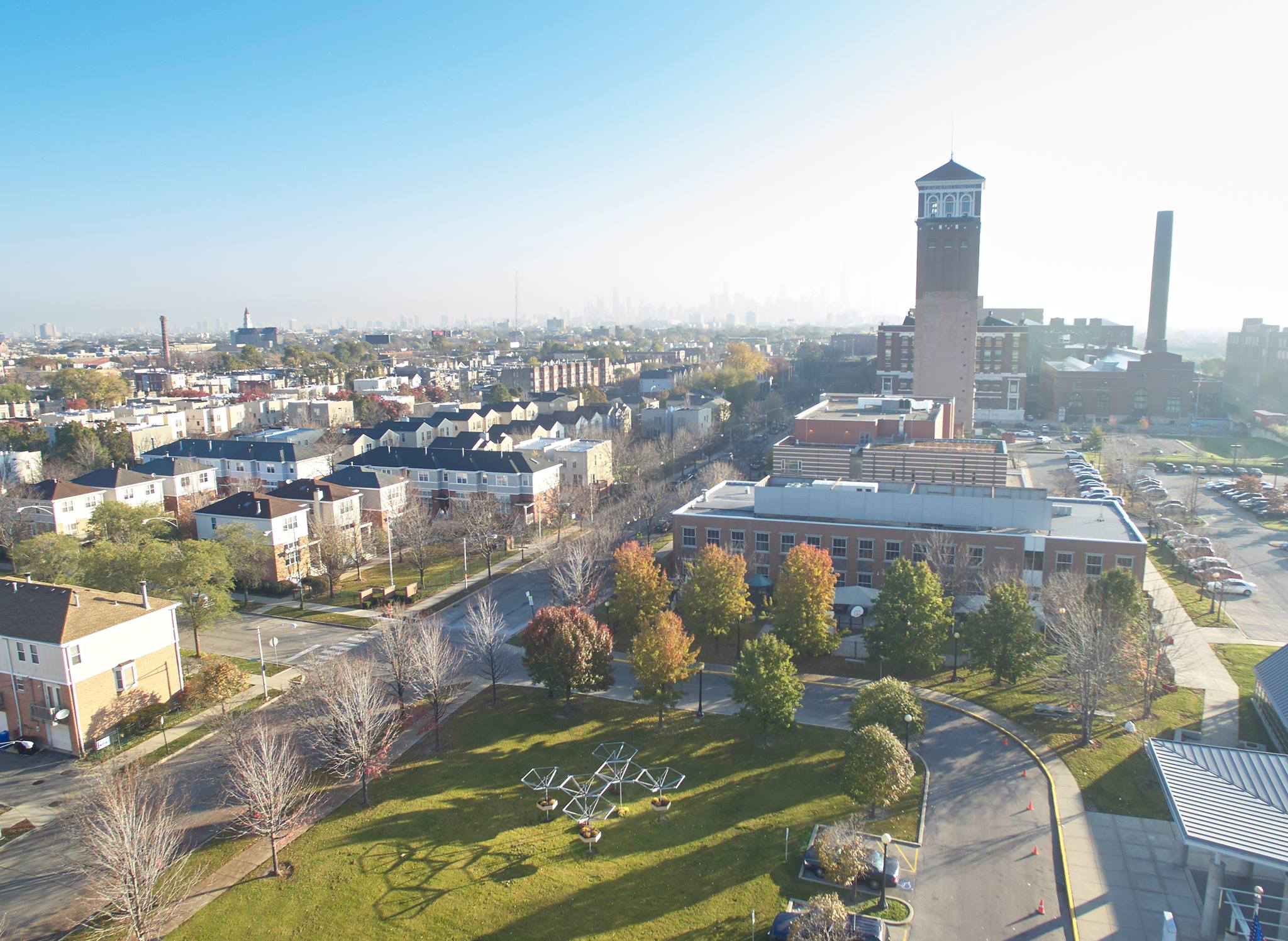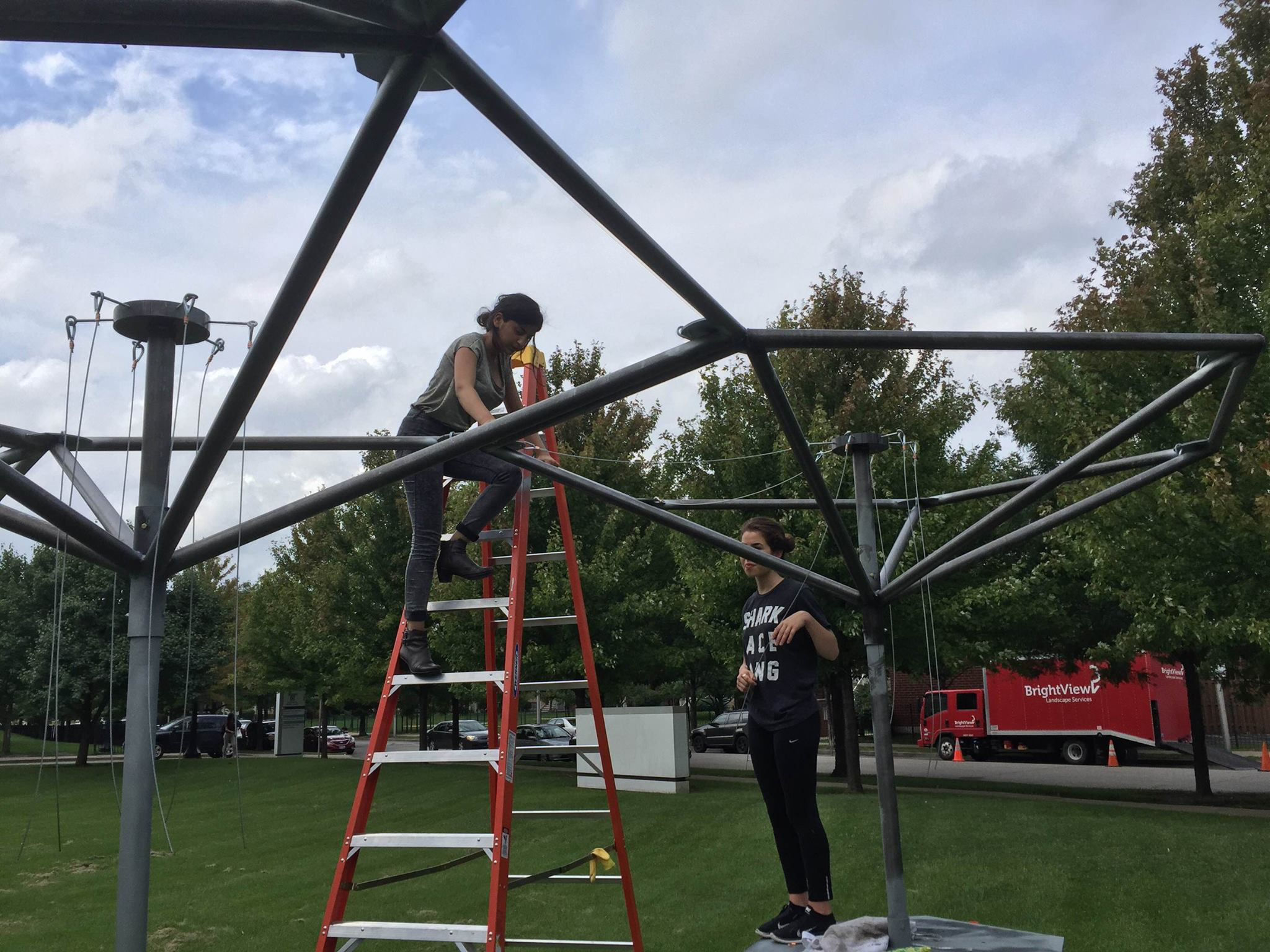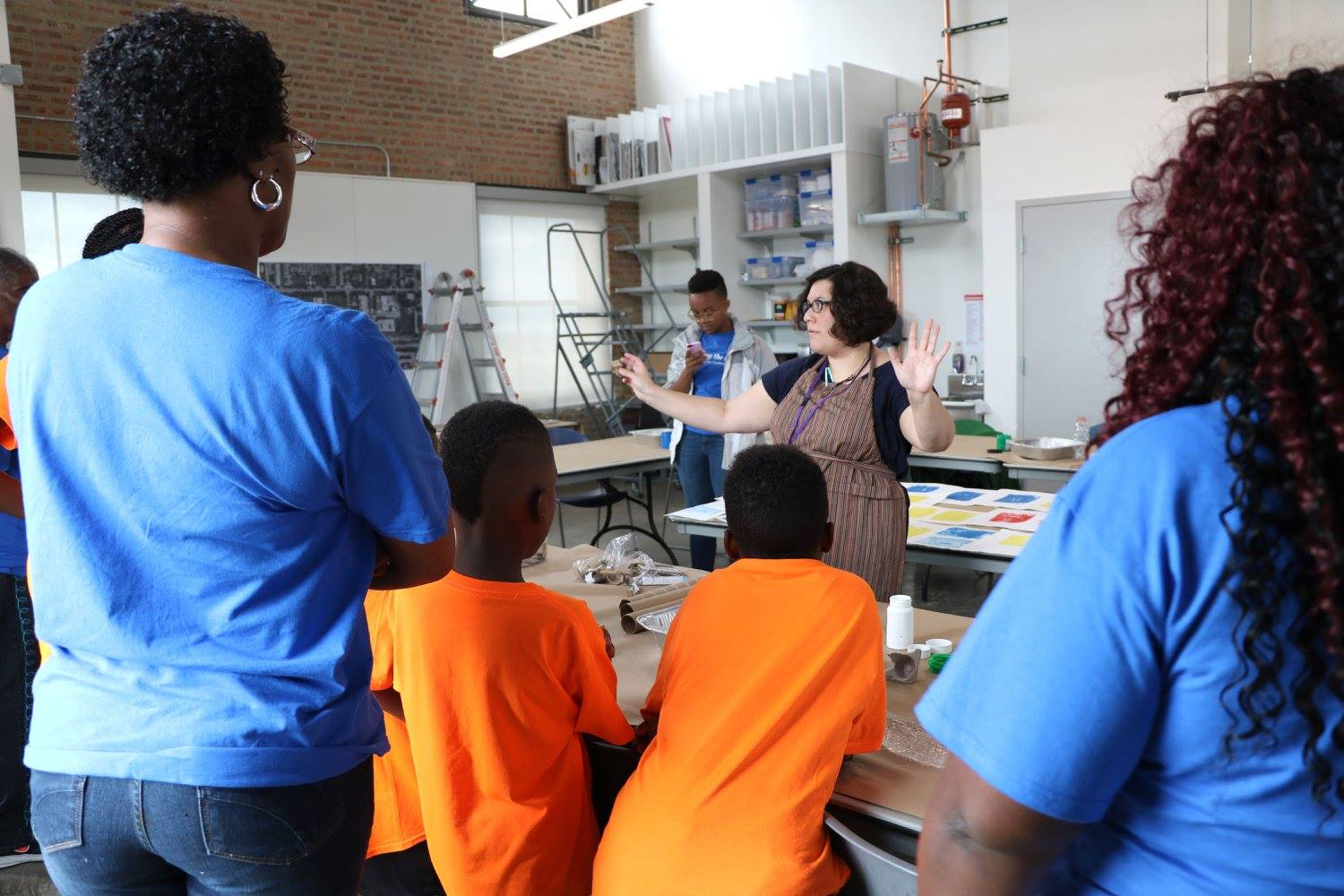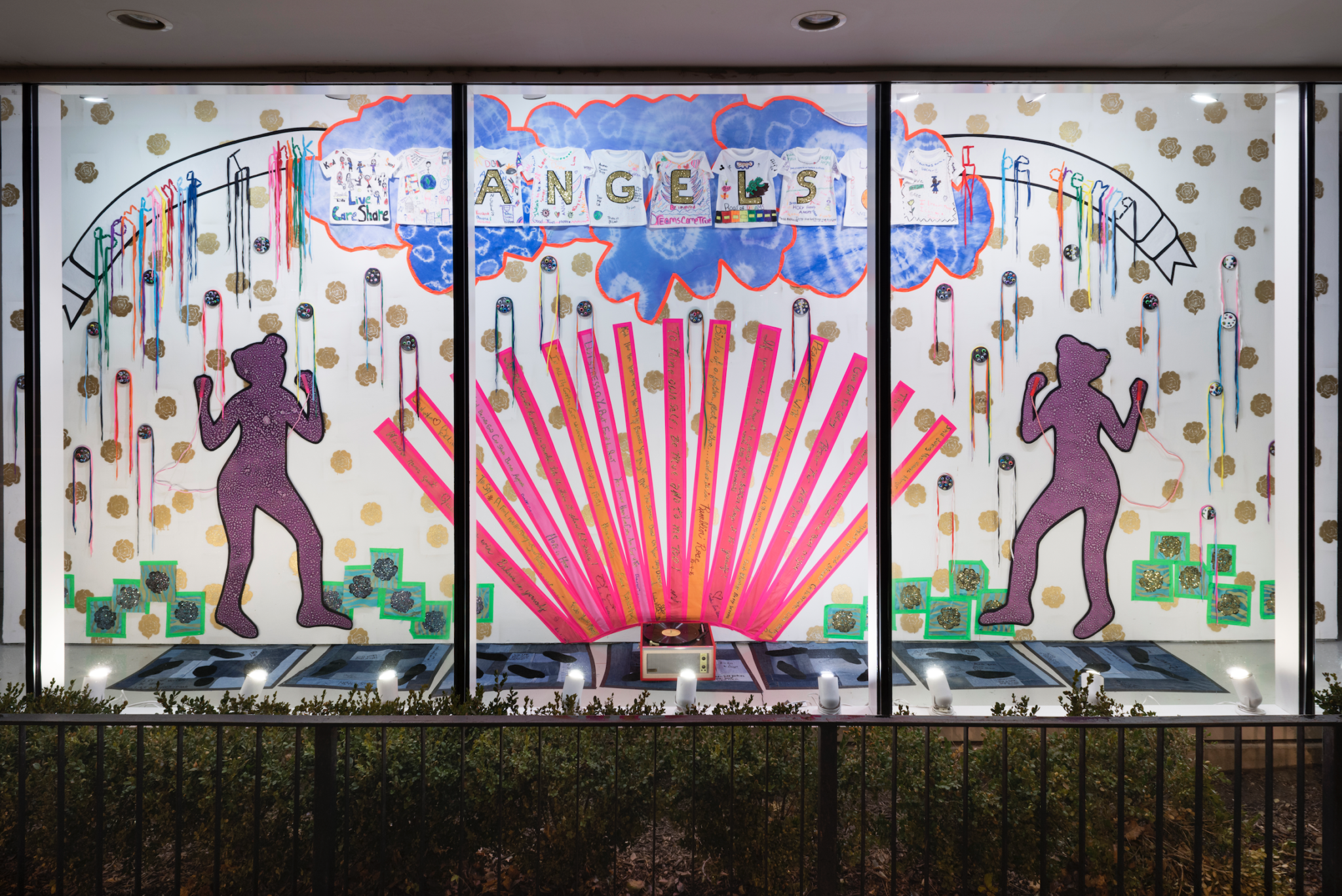A fourteen-story red brick building stands firm, looming above the rows of residential houses that form the Homan Square community of North Lawndale. The words “Sears Roebuck and Co,” written in white, crown the top of the building, and two white columns guard its base.
Formerly Sears’s headquarter space, the building is now called Nichols Tower and houses numerous art, leadership training, and other nonprofit organizations. Among them is the School of the Art Institute of Chicago (SAIC), which was invited by the Foundation for Homan Square last year to run an art center in the tower.
SAIC currently operates three types of programs through the center: residencies for artists, degree-granting courses for SAIC students, and continuing studies courses for local residents of all ages. The school aims for the center to “primarily benefit the neighborhood,” said Jaclyn Jacunski, research associate at SAIC’s Earl and Brenda Shapiro Center for Research and Collaboration. With that perspective, it seems fitting that the fourteenth floor of Nichols Tower has windows on all four walls, providing those inside a near 360-degree view of the surrounding community it serves.

Visible when looking westward from the top floor windows is a daycare center, an elementary school, and a park—all developed by the Foundation for Homan Square in the last twenty years. The Sears catalog plant that used to stand in their place was demolished just prior to their development, many years after Sears moved its headquarters downtown to the Willis Tower in 1974 and closed the plant. According to Taykhoom Biviji, SAIC’s Homan Square Community Coordinator, the move left residents who worked in the plant unemployed, causing many to leave and the number of residents in North Lawndale to drop from 135,000 before the move to 38,000 today.
SAIC’s artist residency program has been heavily involved with this newly built community hub. Sculptor and performer Cheryl Pope, who recently concluded her residency, worked with students from the elementary school, seniors from the park district community center, and other youth in the surrounding area to create a textile mural. Pope said she did not plan beforehand who in the community she would work with; she invited groups of all ages to contribute, and the piece became an amalgam of their works.
For the mural, the elementary students drew images of their dreams for the future on t-shirts and fastened them onto pieces of fabric shaped as clouds. The seniors wrote words of wisdom on strips of fabric that were arranged as sun rays.
“They’re like the bookends of the day…the beginning and the end,” Pope said, “hold[ing] the community together in that way.”
The mural also contains round mirrors with imitation eyes stuck on, representing the spirits of those no longer physically present in the neighborhood. Pope said they included this to represent the whole community, because “these spirits are with us…[for example] when somebody is killed, they are not gone.” The mirrors catch and reflect the sunlight, “just as we reflect and think about them, and feel them near us.”
Pope says she sees her art as poetic journalism, a means to include the “felt experience” beyond the “narrow, linear narrative generated by institutionalized contacts such as the newspaper.” In her eyes, SAIC’s artist residency program at Homan Square is helping the community better express and document this felt experience “not [by] bringing art to the community—the arts have always been in the community,” but by acting as “a new support system.”
To improve this support system, Pope suggested that SAIC extend the residencies to be six months rather than three, to allow artists to establish stronger relations with the community. As her residency was ending, she realized, “Oh, yeah, I’m not going anywhere…I just get in too deep.”
Looking further west from the tower’s top floor, past the community center, is a small grassy area featuring several umbrella-shaped sculptures. These are arrangements of grow lights: LED lights that emit specific wavelengths to maximize the absorption of light energy by plants in order to help them grow. These sculptures were constructed through one of SAIC’s degree-granting courses run from the center.

The installation, called bLUMEN, was conceived with the aim of creating an outdoor structure that addresses safety by providing light at night, and promotes healthy eating by providing locally grown produce sustained through the energy produced by that light.
Throughout the course (also called bLUMEN), the project developed into a community effort, Jacunski explained. SAIC students ran a booth in the North Lawndale Arts Fair, asking locals for input on the project. The course’s professors, Petra Bachmaier (of the Luftwerk art collaborative) and Iker Gil (of MAS Studio), also scheduled community leaders to talk to students. These leaders included Robin Cline, assistant director of the urban land trust NeighborSpace, and Sheila McNary, chairman of the arts and culture committee of North Lawndale Community Coordinating Council. Additionally, the Homan Square Housing Association provided feedback as part of the students’ midterm and final.
The course strove to “be flexible to change directions,” said Jacunski, to ensure that the project was as informed by the community as possible. When members of the community asked for an informational plaque to be installed with the piece, the school ordered the plaque. Residents also requested seating near the sculpture, which is now on track for a designer, according to Jacunski. SAIC appears to be fulfilling its promise for responsive action.
However, Roderick Sawyer, an SAIC student who took a different degree-granting course on hip-hop pedagogy, said these courses could actually be more community-driven. For example, his class created a gallery with artist interviews and a global research project, but Sawyer thought the semester could have been better spent talking to residents about their desires. Sawyer said SAIC could improve its outreach by “really just talking to people [more] …[to] really start supporting what others are doing already in the community.”
“We don’t want to put things in the community, we want to help the community build themselves up,” he said. He attributes part of this need for improvement to the newness of the program. To that end, Jacunski said that SAIC is working toward having initiatives such as these “totally run by the community,” and for SAIC to “give [residents] the keys”—that is, resources for carrying out the initiatives.
Pope says that SAIC is beginning to achieve this. A strength of the school’s faculty members, according to Pope, “is that they listen, that they respond, and that they respond quickly.” For example, she proposed an idea for the school to invite local artists to the tower for a show-and-tell event called “Make Share.” SAIC ran the event the next week.
“The community [is] guiding us…because we’re still outsiders,” Biviji said. “We don’t want to tell anyone we know what’s good for you, what’s bad for you…[the] only thing we can do right now is listen.”
Looking to the south from the top floor, an expansive graffiti mural graces the railroad berm, completed by students in a continuing studies course “The Art of Graffiti,” held this past summer.
This course, along with the others that SAIC offers to the community, is designed around considerations of oral history interviews with local residents, surveys completed by neighborhood partners, and two years of meetings with community organizations, Jacunski said.
The mural, depicting giant letters spelling out “peace,” seems to contrast with the nearby Homan Square police station, which recently drew heavy media attention. In 2015, The Guardian revealed that thousands of people had been detained there over the course of nearly two decades, with most arrestees denied access to lawyers and many subjected to physical violence.
Biviji said that media coverage focused solely on such incidents has obscured the “good that is not reported.” “Twenty years of hard work [conducted by the Foundation for Homan Square and local residents in restructuring the neighborhood]…is written off in a [headline].”

Homan Square’s “complicated” situation—as Jacunski put it—is evident in the juxtaposition between the critical atmosphere surrounding the police station and the unity expressed through the “peace” mural. Crashun Jones, a young man from the community who was hired as a youth ambassador by SAIC to review the continuing studies courses, voiced how the graffiti course brings to light the talent and aspirations of the teenagers taking it.
“When you come to Lawndale, you would be surprised…There’s a lot of kids that actually know how to draw, but they don’t really put their artwork out there…they feel they won’t be paid attention to,” he said. “[It’s] crazy that you can find artwork in places other than just in downtown or up north.”
He expressed a similar review for another continuing studies course held in the summer, “Our Stories, Our Sounds,” a DJ and podcast course. As part of the class, Lawndale students commuted to SAIC’s downtown campus to record at the school’s radio station.
“Not a lot of people can talk publicly in front of people,” Jones said. At the end of the course though, many students “actually opened up a little more to society by not being afraid to talk in front of a crowd of people…[and] not scared to express their opinions.”
Whether or not the students pursue an arts-related profession, the courses are “worthwhile because you learn, you pick up a skill, and have fun while learning,” said Jones.
To the east, far away even from fourteen floors up, is the Chicago skyline. Skyscrapers, short and tall, and roofs, sharp and round, form the city’s silhouette. The pointed antennae of the Willis Tower distinctly jut out.
“I didn’t have that height and perspective growing up,” Jacunski said, “to look out on the view of your city and ask questions.” Jones said he used to draw buildings when he was young, because he wanted to be an architect. He “wanted to build a city,” he said. Now, standing on the top floor looking east, “It’s inspiration! ’Cause you can see the whole city.”
Looking back down from the sight of Chicago’s skyline is the immediate North Lawndale community, sprawling before you. The view contains both the residents whom SAIC’s programs aim to benefit and the question of how to best do so.
“There still needs to be more involvement,” said Sawyer. “We don’t want to be in this space and use it to just use it, we really want to be there to help create for the community.”
Pope described a time she shared this heightened view. “We’re looking out over the city,” she recalled. “By being in this space that is elevated…you change an angle, you get to see yourself differently.” The change in vantage point mirrors a similar shift in perspective that arts education can provide. The possibility of increasing accessibility to this changed outlook—“that’s what’s exciting about the arts being here.”
Did you like this article? Support local journalism by donating to South Side Weekly today.

